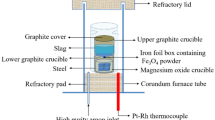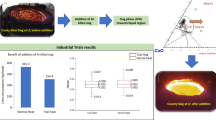Abstract
Quality requirement of customers are becoming more stringent w.r.t low level of sulphur in final product for better mechanical property of steel. High sulphur in steel leads to poor internal quality in the form of cracks and sometimes causes breakout during continuous casting of steel. In past, various studies have been carried out to investigate the desulphurisation process in steelmaking. But most of the work has been focused on desulphurisation of steel with high-basicity slag and in steels killed by aluminium. However, many steel grades which are silicon killed are having low slag basicity. Very few studies are available on desulphurisation of steels deoxidised with Si–Mn and having a low basicity slag comprising of system CaO–SiO2–MgO–Al2O3. Durgapur Steel Plant, a unit of Steel Authority of India Limited was facing problems of high sulphur in steels which were subjected to silicon killing. Final sulphur in Si-killed steels at Durgapur Steel Plant (DSP) was 0.028% average. High sulphur in steel was one of the bottlenecks in improving the quality of steel as well as one of the reasons of low throughput of continuous casters at DSP. De-Sulphurisation of silicon killed steel is a difficult task owing to inherent nature of steel melt as well as ladle top slag. In case of Si killed steel, the ladle top slag which is basically siliceous in nature has a lower sulphide capacity, lower sulphur partition ratio, and adverse physio-chemical characteristics. Also the oxygen potential of both the bath as well as slag is higher as compared to normal Al killed steels. The present work was carried out in improving the desulphurisation level in steels subjected to silicon killing. Slag engineering was done in a novel way to make conditions more conducive for desulphurisation of steels. Deoxidation and flux addition practice was modified in an innovative way to decrease the SiO2 generation and also to reduce the oxygen potential of slag. Plant scale trials were conducted with modified deoxidation and flux addition practice. 60% De-S was achieved in heats i.e. sulphur reduction from 0.039% (S in hot metal) to 0.015% (S in final product). Morphology and composition of inclusions were also investigated by SEM–EDS to compare the effects in modified practice. A process technology was established for production of low sulphur steels at DSP, SAIL.
Access this chapter
Tax calculation will be finalised at checkout
Purchases are for personal use only
Similar content being viewed by others
References
Buĺko B, Kijac J, Domec M (2009) Optimalization slag composition in ladle furnace considering to effective steel desulfurization. Acta Metallurgica Slovaca 15(2):93–99
Pretorius EB (2015) Fundamentals of EAF and ladle slags and ladle refining principles. https://www.semanticscholar.org/paper/Fundamentals-of-Eaf-and-Ladle-Slags-and-Ladle-PretoriusRefractories/5109946bfbb401ec66c8bf13bc34298c48b6be59
Andersson MA, Jönsson PG, Nzotta MM (1999) Application of the sulphide capacity concept on high-basicity ladle slags used in bearing-steel production. ISIJ Int 39(11):1140–1149. https://doi.org/10.2355/isijinternational.39.1140
Xu JF, Huang FX, Wang XH (2016) Desulfurization behavior and mechanism of CaO-saturated slag. J Iron Steel Res Int 23(8):784–791. https://doi.org/10.1016/S1006-706X(16)30121-2
MM N, Sichen D, Seetharaman S (1998) Sulphide capacities in some multi component slag systems. ISIJ Int 38(11):1170–1179.https://doi.org/10.2355/isijinternational.38.1170
Atlas S (1995) Verein deutscher eisenhüttenleute. Verlag Stahleisen GmbH, Düsseldorf, 5, pp 258–259
Boström A (1997) A model for multi component reactions between metal/slag using thermo-calc: applied for removal of sulphur during ladle treatment (Doctoral dissertation, Institutionen för tillämpad process metallurgi). (Licentiate thesis, 1997, KTH)
PG J, Jonsson L, Sichen D (1997) Viscosities of LF slags and their impact on ladle refining. ISIJ Int 37(5):484–491.https://doi.org/10.2355/isijinternational.37.484
Acknowledgements
The authors are grateful to the officials and management of Durgapur Steel Plant and RDCIS for providing their support to carry out the present work. Full support was provided by the personnel of SMS Shop and R&C Lab of DSP during the execution of the project work is thankfully acknowledged.
Author information
Authors and Affiliations
Corresponding author
Editor information
Editors and Affiliations
Rights and permissions
Copyright information
© 2022 The Author(s), under exclusive license to Springer Nature Singapore Pte Ltd.
About this paper
Cite this paper
Kumar, S. et al. (2022). An Innovative Slag Engineering Approach for Improving De-Sulphurisation Efficiency in Silicon Killed Steels. In: Kumari, R., Majumdar, J.D., Behera, A. (eds) Recent Advances in Manufacturing Processes. Lecture Notes in Mechanical Engineering. Springer, Singapore. https://doi.org/10.1007/978-981-16-3686-8_17
Download citation
DOI: https://doi.org/10.1007/978-981-16-3686-8_17
Published:
Publisher Name: Springer, Singapore
Print ISBN: 978-981-16-3685-1
Online ISBN: 978-981-16-3686-8
eBook Packages: EngineeringEngineering (R0)




